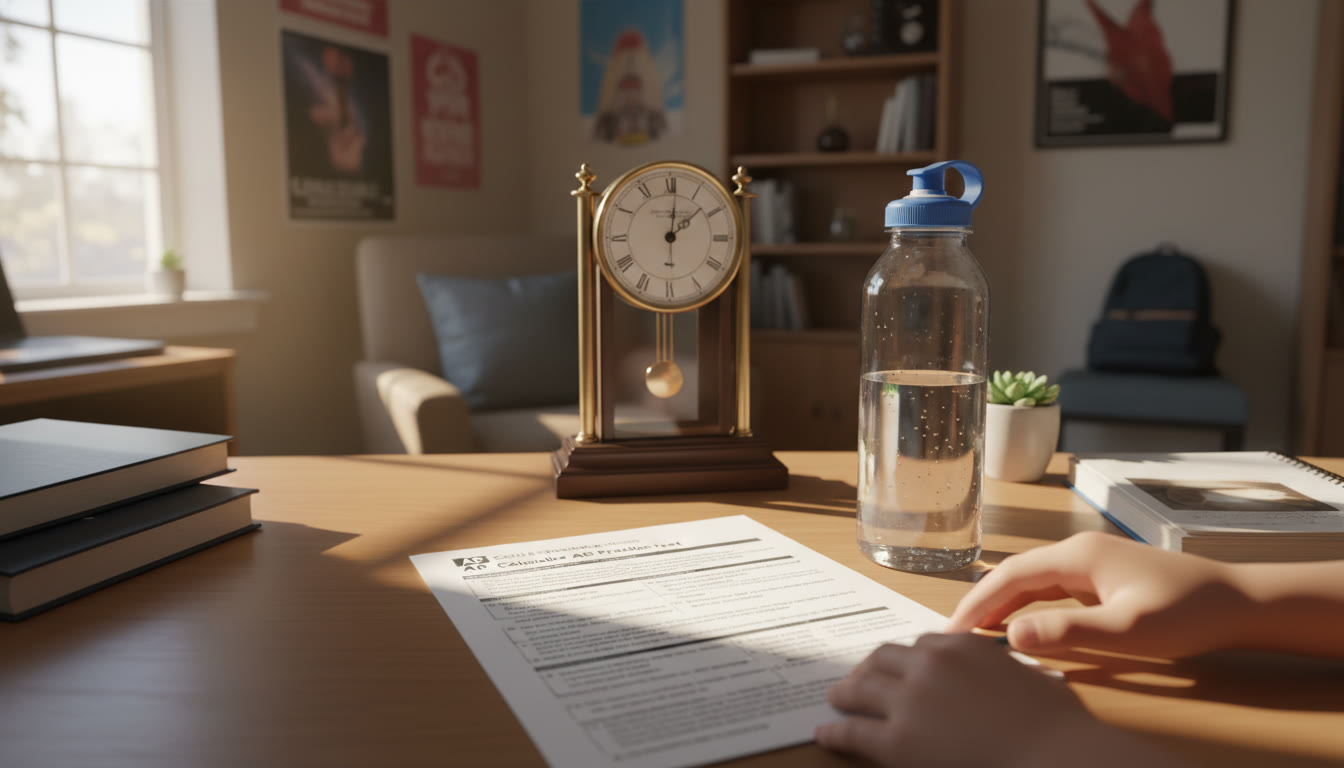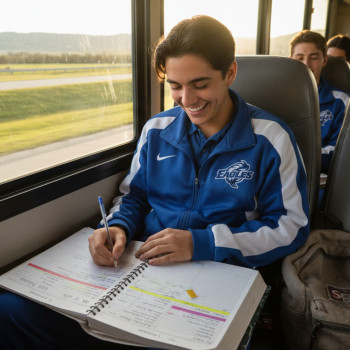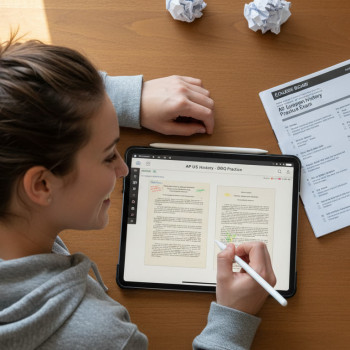Why Full-Length Simulations Matter (And Why You Should Treat Them Like the Real Exam)
Taking a full-length AP simulation isn’t just another practice run — it’s the single most valuable rehearsal you can give yourself before exam day. Think of it as a dress rehearsal where timing, stamina, focus, and strategy meet all at once. Short drills and review packets build skills; full-length simulations train you to apply those skills under the same pressure, pacing, and mental fatigue you’ll face when the stakes are real.

Why does this matter? Because AP exams test knowledge and endurance. When you’re comfortable with a four- or three-hour testing rhythm, you reduce the cognitive load of ‘‘how do I pace myself?’’ and reserve energy for higher-level thinking. Scheduled, repeated simulations normalize the experience so that by May (or your AP test month) you’re running on practiced autopilot rather than uncertainty.
Principles to Follow When Scheduling Simulations
Effective simulations are not random. They follow a set of principles designed to maximize transfer from practice to performance:
- Realism: Match the exam format (digital or paper), section order, and timing exactly.
- Consistency: Run simulations at the same time of day you’ll take the real exam whenever possible.
- Spaced Repetition: Schedule simulations across weeks and months rather than clustering them all at once.
- Data-Informed: Treat each simulation as data — log scores, time per question, and patterns of fatigue or distraction.
- Reflection: Build time for analysis after each simulation. What went well? Where did you lose time?
How Many Full-Length Simulations Should You Do?
Quality beats quantity. For most students, a practical plan is:
- Early-season baseline: 1 simulation (to identify weak spots).
- Mid-season: 2–3 simulations spaced 2–3 weeks apart (practice adjustments).
- Pre-exam peak: 1–2 simulations within the final 3–4 weeks (dress rehearsal).
This adds up to roughly 4–6 full-length simulations during a school year. Advanced students or those converting borderline scores may choose to do more, but each simulation should be followed by targeted remediation — otherwise you’re repeating the same errors.
Designing a Realistic Simulation Schedule
Below is a sample 12-week block plan for students preparing for a May AP exam. It assumes weekly study with full-length simulations at strategic points.
| Week | Focus | Activity |
|---|---|---|
| 1 | Baseline | Full-length diagnostic simulation; detailed review |
| 3 | Targeted Content | Focused practice on weakest units + short timed sections |
| 5 | Pacing Practice | Half-test timed blocks to train pacing |
| 7 | Mid-point Simulation | Full-length simulation; review and strategy update |
| 9 | Exam Skills | Free-response practice and rubric calibration |
| 11 | Pre-Exam Simulation | Final full-length simulation under strict conditions |
| 12 | Recovery and Taper | Light review, sleep optimization, and mental prep |
Adjust timing based on your own school calendar and when your AP subject moves key topics. The goal is to arrive at the exam with one recent, clean simulation and a clear, short checklist of last-minute focus items.
Session Protocol: Before, During, and After
Before the Simulation
- Choose a testing location that mimics the exam room: quiet, comfortable, neutral temperature, and without interruptions.
- Use the same devices and materials you’ll use on test day (for digital AP exams, practice with the testing app — if you don’t have official access, emulate the environment as best possible).
- Prepare logistics: snacks, water, ID, a timer, scratch paper, and a full battery on devices.
- Set your brain: get a normal night’s sleep, avoid cramming the evening before, and do a short review of test structure (not content overload).
During the Simulation
- Treat timing strictly. If a section is 60 minutes, time it to the minute. For extended time accommodations, practice with the approved timing pattern.
- Keep a visible clock. Practice decisions about when to skip and return to hard items.
- Simulate breaks exactly as they would occur on exam day. If the real exam has a 10-minute break after Section II, schedule the same break during practice.
- Log time on hard questions — note how long you spend before deciding to move on.
- For digital exams, practice navigation and flagging strategies to mirror the actual test interface behavior.
After the Simulation
This is where the magic happens. Don’t just glance at your score — dissect it.
- First, record raw scores, timing breakdowns, and subjective notes about fatigue or focus lapses.
- Spend a full session reviewing every missed question: was the error content-based, careless, or timing-based?
- Create micro-targets (1–3 items) to practice before your next simulation. For example: ‘‘Practice setting up AP Calculus free-response problems involving related rates until I can do three in a row without prompts.’’
Tracking Progress: Metrics That Actually Tell You Something
Not all data is useful. Track metrics that directly predict exam-day performance:
- Section scores (not just overall percent) — this helps prioritize topics.
- Time per question averages and distribution (where did you spend too long?).
- Number and type of skipped questions.
- Free-response rubric alignment: how many points did you lose to structure versus content?
- Stamina flags: when did you begin to slow down or make careless mistakes?
Example Progress Log (Simple Format)
| Simulation | MCQ % | FRQ Avg Points | Timing Issues | Action Plan |
|---|---|---|---|---|
| Baseline | 62% | 6/12 | Slow on Section 2 | Timed drills on Section 2, daily review of Topic X |
| Midpoint | 72% | 8.5/12 | Careless errors in MCQ | Answer-check routine and pausing checklist |
| Pre-Exam | 78% | 10/12 | Fatigue after 2.5 hours | Build stamina with longer study blocks and practice breaks |
Accommodation Considerations (Important)
If you have approved accommodations, replicate them in every simulation. If you’re in the process of applying for accommodations, practice both with and without them so you understand how each scenario affects pacing and strategy.
- Extended time changes pacing. Practice section-by-section timing to learn when to allocate extra minutes.
- Multiple-day testing needs specific rehearsal: split long simulations across days while maintaining the same focus and continuity of thought.
- If you use assistive technology, include it in your practice so you’re fluent in the tools.
Common Pitfalls and How to Avoid Them
Students often sabotage simulations unintentionally. Here are the most frequent pitfalls and simple fixes:
- Pitfall: Doing simulations too frequently without remediation. Fix: Always follow a simulation with targeted practice sessions.
- Pitfall: Practicing in low-stakes environments (music on, constant interruptions). Fix: Create strict testing conditions that mimic the exam.
- Pitfall: Ignoring mental and physical needs. Fix: Prioritize sleep, hydration, and short active breaks to train stamina.
- Pitfall: Overfocusing on score percent instead of root causes. Fix: Analyze mistakes by type — content, strategy, or stamina.
How to Integrate Short Practice with Full-Length Simulations
Think of short practice as the muscles and full-length simulations as the marathon. Use short, focused practice sessions to correct the specific errors your simulation feedback reveals.
- Use 20–30 minute micro-sessions for single-skill drills (e.g., AP Chemistry stoichiometry setups, AP US History sourcing statements).
- Mix active recall and spaced repetition for content retention between simulations.
- Include timed mini-sections to work on pacing without committing to a full simulation every time.
When to Bring in Personalized Tutoring
Full-length simulations reveal persistent, stubborn weaknesses that short review alone won’t fix. That’s where personalized tutoring adds the most value.
If after two simulations your mid-section score lags, or your free-response structure keeps losing points, a tutor can provide targeted strategies — whether that’s efficient setups for problems, rubric-driven writing templates, or pacing mechanics. Sparkl’s personalized tutoring can help here with 1-on-1 guidance, tailored study plans, and expert tutors who turn simulation data into actionable practice. Their AI-driven insights can make sense of patterns across multiple tests and recommend a sequence of focused drills to close gaps efficiently.
Mental Strategies for Simulation Day
- Start with a brief centering routine: three deep breaths, a short positive self-talk script, and a quick plan outline for each section.
- Use a ‘‘pause-and-plan’’ habit before each section: glance at the section’s structure and set mini goals (e.g., ‘‘Finish first 30 MCQs in 35 minutes’’).
- When fatigue hits, switch to technique: shorter breaths, recalibrated timing checkpoints, and switching question strategies (eliminate before solve).
- After each break, re-anchor by checking your posture, water, and a two-line checklist to refocus quickly.
Using Simulation Data to Personalize the Final Weeks
In the final month before the exam, simulations should shape your daily study plan. Convert your simulation findings into a prioritized checklist:
- Top 3 content areas to review live each day.
- Two types of timed drills to improve pacing.
- One free-response kernel to practice every other day.
Personalized tutoring, like Sparkl, can accelerate this phase by creating study plans from your simulation data, providing quick feedback on practice FRQs, and offering short checkpoint sessions to keep you accountable without burning out.
Final Week Protocol: Taper, Tune, and Trust Your Process
The last seven days are about reducing volume and sharpening execution:
- Day -7: One short simulation if you feel you need it; otherwise skip to focused weak-point review.
- Day -5 to -3: Light practice, quick timed sections, maintain sleep schedule.
- Day -2: Avoid heavy studying; do a brief run-through of test structure and logistics.
- Day -1: Rest, eat well, and mentally rehearse positive test-day behaviors.
- Exam Day: Follow your practiced protocol: breakfast, arrival buffer, and breathing routine.
A Sample Checklist for Simulation Day
- Timer set and visible
- Materials prepared (ID, pencils, erasers, calculator if allowed)
- Phone off and stored away
- Water and allowed snack ready for official break
- 25-minute buffer before starting (to settle nerves)
Closing Thoughts: Practice Intelligently, Not Just Harder
Full-length simulations are powerful because they combine content, strategy, and the unpredictable human element of fatigue. The best improvements come from doing simulations with discipline — realistic timing and conditions — and then using the results to drive targeted practice. Track the right metrics, schedule simulations thoughtfully across the preparation arc, and don’t be afraid to bring in personalized support when patterns persist. Smart coaching or tutoring can transform simulation data into a sharp, efficient plan focused on the few changes that yield the biggest score gains.

Remember: your goal is not to love the test but to learn how to perform steadily on the test. Treat each simulation as feedback, not judgment. With a clear protocol, consistent data tracking, and targeted practice — possibly augmented by 1-on-1 guidance like Sparkl’s tailored tutoring and AI-driven insights — you’ll be far more likely to enter exam day calm, prepared, and ready to translate practice into score.
Quick Reference: Simulation Protocol Summary
- Schedule 4–6 full-length simulations across your prep cycle.
- Replicate exam conditions exactly (timing, breaks, materials).
- Track section-level scores, timing, skipped questions, and fatigue.
- Always follow a simulation with targeted remediation.
- Use tutoring for persistent patterns; focus on strategy and execution.
- Taper properly in the final week and trust your practice on exam day.
Good luck — and remember, simulations are your rehearsal for success. The more realistic and reflective your rehearsals, the more confident and composed you’ll be when the real performance arrives.




















No Comments
Leave a comment Cancel